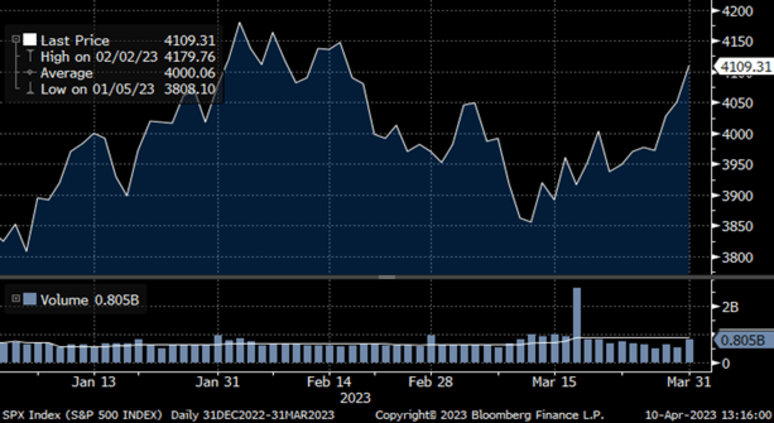April 26, 2023
Lessons from March’s Bank Run

The misdirect
Investors began the year with an extremely optimistic belief that an economic soft landing would be achieved in the U.S. with cooling inflation and that the U.S. Federal Reserve was very close to finished hiking rates. The S&P 500 Index rose to 4180 during the quarter (see chart below). This optimistic expectation was later challenged by continued strength in the labour market that is expected to drive higher input costs and inflation. Markets quickly weakened and fell substantially when bank run news hit the wire in March.
The ”solution”
It was obvious the Silicon Valley Bank and the Signature Bank would not survive on their own and a few others were also at risk of failing. The Federal Reserve and U.S. Treasury came to the rescue quickly by assuring deposits are safe and by announcing a new program, the Bank Term Funding Program (BTFP), to allow banks to borrow from the Fed using their holdings of government bonds as collateral. The crisis ended quickly, and the equity markets resumed rising on the expectation that the Federal Reserve has to put financial stability ahead of fighting inflation, hence lower terminal interest rates and possibly cuts by end of year.
Year-to-date index performance of the S&P 500 Index:

Source: Bloomberg Finance, L.P.
The outcome
Stocks are higher, and bonds are also higher broadly on the expectation of lower rates. Shall we just ignore this bank crunch or is there something to be learned? Below are our key takeaways from the current environment:
1. All banks rely heavily on leverage to generate margins and profits. None will have liquidity in short order to satisfy a bank run. As a result, there is a role for central banks to play in an emergency.
2. Deposit insurance has a limit; in Canada it is $100,000. Central banks can print unlimited amounts of money. As long as they are willing, money is not an issue!
3. Government bonds and T-bills are the safest investment as the borrower can print money to pay you, while banks cannot.
4. After the failures of Bear Stearns, Lehman Brothers, and Credit Suisse, investors should understand by now that no single bank is absolutely safe and they should diversify their investments by country, sector, and by names within the sector. It is the old saying, “don’t put all your eggs in one basket.”
5. The current shock will likely have implications:
a. Banks will be more defensive in lending, hence tightening credit conditions, especially for lower quality borrowers. This also means the risk of recession in the next six to nine months is higher.
b. Depositors are finding alternatives to deposits, such as T-Bills and money market funds, for higher interest and higher security. This means banks may continue to lose deposits not because of safety concerns, but price.
6. Central banks are influential on the banking system and economies. They have been more active lately as there were more crises than normal in the last two decades. The Fed balance sheet has expanded every time a crisis occurs and only shrinks marginally. It stands at $8.7 trillion today vs. $4 trillion in 2020.
The value of money is questionable, and probably does not get questioned enough. The resurgence of interest in gold bullion and cryptocurrencies suggests there is a growing force voting against central banks. Will they be able to mitigate risks and contain losses, or will further shockwaves hit the broader banking system?
Investors’ optimism turned sour in March as Silicon Valley Bank and Signature Bank failed, yet outlooks and markets rebounded on the expectation that the Fed would prioritize the banking system ahead of fighting inflation. The Bank Term Funding Program (BTFP) was launched to allow banks to borrow from the Fed using government bond holdings as collateral. This move showcased the vital role of central banks in a crisis, while also exposing the ability for cash to be manipulated and fuelling a resurgence of interest in cryptocurrencies and gold bullion as alternative deposits.
Glossary of Terms
Leverage: An investment strategy of using borrowed money – specifically, the use of various financial instruments or borrowed capital – to increase the potential return of an investment.
Liquidity: The degree to which an asset or security can be quickly bought or sold in the market without affecting the asset’s price. Cash is considered to be the most liquid asset, while things like fine art or rare books would be relatively liquid.
About the Author
Alfred Lam, Senior Vice President, Co-Head of Multi-Asset, joined CI GAM in 2004. He brings over 23 years of industry experience to his portfolio design, asset allocation, portfolio construction, and risk management responsibilities, which include chairing the multi-asset investment management committee and sizing investment bets to drive added value and manage risk. Alfred holds the CFA designation and an MBA from York University Schulich School of Business.
IMPORTANT DISCLAIMERS
The opinions expressed in the communication are solely those of the author(s) and are not to be used or construed as investment advice or as an endorsement or recommendation of any entity or security discussed. This document is provided as a general source of information and should not be considered personal, legal, accounting, tax or investment advice, or construed as an endorsement or recommendation of any entity or security discussed. Every effort has been made to ensure that the material contained in this document is accurate at the time of publication. Market conditions may change which may impact the information contained in this document. All charts and illustrations in this document are for illustrative purposes only. They are not intended to predict or project investment results. Individuals should seek the advice of professionals, as appropriate, regarding any particular investment. Investors should consult their professional advisors prior to implementing any changes to their investment strategies.
Certain statements in this document are forward-looking. Forward-looking statements (“FLS”) are statements that are predictive in nature, depend upon or refer to future events or conditions, or that include words such as “may,” “will,” “should,” “could,” “expect,” “anticipate,” “intend,” “plan,” “believe,” or “estimate,” or other similar expressions. Statements that look forward in time or include anything other than historical information are subject to risks and uncertainties, and actual results, actions or events could differ materially from those set forth in the FLS. FLS are not guarantees of future performance and are by their nature based on numerous assumptions. Although the FLS contained herein are based upon what CI Global Asset Management and the portfolio manager believe to be reasonable assumptions, neither CI Global Asset Management nor the portfolio manager can assure that actual results will be consistent with these FLS. The reader is cautioned to consider the FLS carefully and not to place undue reliance on FLS. Unless required by applicable law, it is not undertaken, and specifically disclaimed that there is any intention or obligation to update or revise FLS, whether as a result of new information, future events or otherwise.
Certain statements contained in this communication are based in whole or in part on information provided by third parties and CI Global Asset Management has taken reasonable steps to ensure their accuracy. Market conditions may change which may impact the information contained in this document. CI Global Asset Management is a registered business name of CI Investments Inc. ©CI Investments Inc. 2023. All rights reserved.
